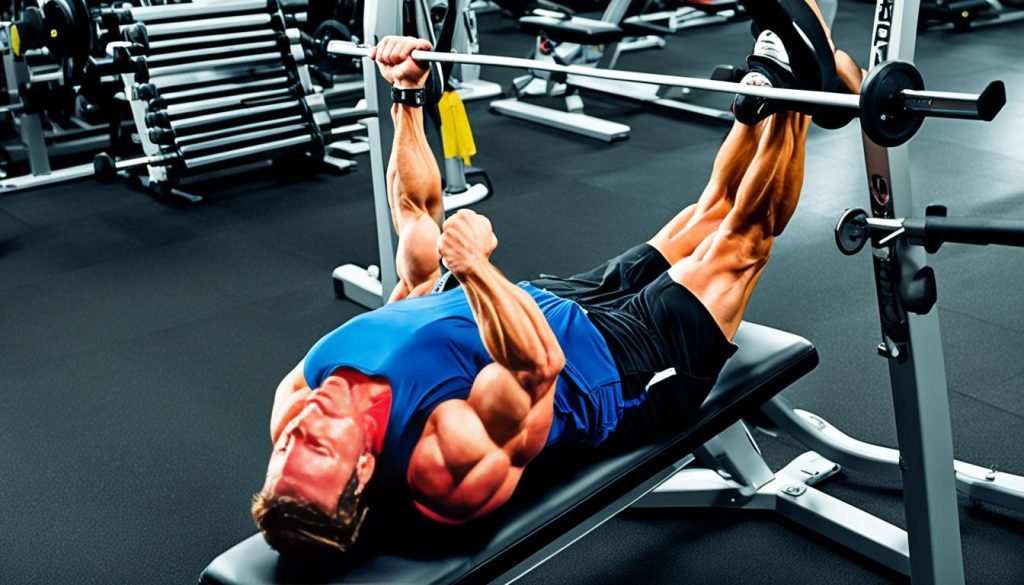Looking to build a strong back? Cable back exercises can be the answer you’ve been searching for. Whether you’re a beginner or a seasoned gym-goer, incorporating cable machine back workouts into your routine can help you achieve your fitness goals.
Cables provide a safe and targeted approach to back training by allowing you to isolate specific muscle groups. With a wide range of exercise variations, you can target different areas of your back for maximum muscle growth and development.
In this article, we’ll explore the benefits of cable back exercises and introduce you to the 8 best cable back workouts that will help you reach new levels of strength and definition. So let’s get started and transform your back with the power of cables.
Key Takeaways:
- Cable back exercises are a safer and more targeted way to build a strong back.
- They allow for isolation of specific muscle groups and offer a wide variety of exercise variations.
- By incorporating cable back exercises into your workout routine, you can improve muscle balance, posture, and overall strength.
- Some of the best cable back workouts include the seated cable row, single-arm cable row, lat pulldowns, cable face pull, cable shrugs, and incline cable pullover.
- Follow proper form and execution for each exercise to maximize the benefits and achieve optimal results.
Benefits of Cable Back Exercises
Cable back exercises offer a range of benefits that can transform your workout routine and help you achieve your fitness goals. Whether you’re a beginner or a seasoned gym-goer, incorporating cable exercises into your back workout can bring about significant improvements in muscle strength, balance, and posture.
1. Better Range of Motion: Cable machines provide a smooth and controlled movement pattern, allowing for a greater range of motion compared to traditional free weights. This increased range of motion helps target specific muscle groups effectively, ensuring optimal muscle activation and growth.
2. Isolation of Specific Muscle Groups: One of the key advantages of cable back exercises is their ability to isolate specific muscles. By adjusting the cable height, grip, and angle, you can precisely target the muscles you want to work on, such as the latissimus dorsi, rhomboids, and trapezius.
3. Versatility in Workout Routines: Cable machines offer a vast array of exercise options, allowing you to create diverse and challenging back workouts. You can perform exercises like cable rows, lat pulldowns, and cable face pulls, incorporating different attachments and grips to continuously challenge your muscles.
4. Improved Muscle Balance: Cable back exercises promote balanced muscle development by targeting both larger and smaller muscle groups in the back. This helps correct muscle imbalances and prevents injuries caused by muscle weaknesses.
5. Posture Enhancement: Strong back muscles developed through cable exercises can improve posture by supporting the spine and ensuring proper alignment. This can alleviate back pain and reduce the risk of postural-related issues.
6. Increased Overall Strength: Cable back exercises engage multiple muscle groups simultaneously, leading to overall strength gains. These exercises not only build a strong back but also improve functional strength, making daily activities easier.
Understanding the benefits of cable back exercises can be a driving force in motivating individuals to incorporate them into their training programs. Whether you’re aiming for muscle growth, improved posture, or enhanced overall strength, cable exercises offer a versatile and effective way to achieve your fitness goals.
Sample Workout Routine
| Exercise | Sets x Reps |
|---|---|
| Seated Cable Row | 3 x 12-15 |
| Single-Arm Cable Row | 3 x 10-12 each arm |
| Lat Pulldowns | 3 x 12-15 |
| Cable Face Pull | 3 x 12-15 |
| Cable Shrugs | 3 x 12-15 |
| Incline Cable Pullover | 3 x 12-15 |
Remember to adjust the weight and repetitions based on your fitness level and goals. If you’re a beginner, start with lighter weights and gradually increase as you build strength and confidence. Always prioritize correct form and technique to ensure maximum benefits and reduce the risk of injury.
Seated Cable Row
The seated cable row is a highly effective exercise for targeting the upper back muscles, including the rhomboids, latissimus dorsi, erector spinae, and lower trapezius. It also engages the biceps, triceps, and core, making it a compound movement that works multiple muscle groups simultaneously.
Performing the seated cable row correctly is crucial to maximize its benefits. Here is a step-by-step guide to help you execute this exercise with proper form:
- Start by sitting on the cable row machine with your feet flat on the footrests and knees slightly bent.
- Grab the handle attached to the cable, ensuring your grip is shoulder-width apart and palms facing each other (neutral grip).
- Keep your back straight, chest up, and shoulders relaxed.
- Begin the movement by pulling the handle towards your midsection while squeezing your shoulder blades together. Focus on using your back muscles to initiate the movement, and avoid using excessive momentum or relying on your arms.
- Pause briefly at the fully contracted position, feeling the tension in your back muscles.
- Slowly return to the starting position, extending your arms fully while maintaining control throughout the entire range of motion.
- Repeat for the desired number of repetitions.
The seated cable row provides a controlled and stable environment for targeting your back muscles. It allows you to adjust the weight and resistance based on your fitness level, making it suitable for beginners and advanced individuals alike. Incorporating this exercise into your workout routine can help improve posture, strengthen the back muscles, and enhance overall upper body strength.

Benefits of Seated Cable Row:
“The seated cable row is an excellent exercise for building a strong and well-developed back. It not only targets the major back muscles but also engages the arms and core, providing a comprehensive workout. The controlled movement and adjustable resistance make it suitable for all fitness levels.”
Single-Arm Cable Row
When it comes to targeting specific muscle imbalances and addressing shoulder issues, the single-arm cable row is a game-changer. This unilateral exercise primarily focuses on engaging the lats, providing an effective means of building back strength and size. In addition to targeting the lats, the single-arm cable row also works the rhomboids, trapezius, and biceps.
To perform the single-arm cable row, follow these steps:
- Stand facing a cable machine with your feet shoulder-width apart and knees slightly bent. Grab the handle or attachment with one hand, keeping your palm facing inward.
- With a slight bend in your elbow, pull the handle towards your body while retracting your shoulder blades. Focus on squeezing your back muscles at the top of the movement.
- Lower the handle back to the starting position in a controlled manner, fully extending your arm.
- Repeat for the desired number of repetitions and then switch sides.
Proper form is crucial when performing the single-arm cable row to maximize its benefits and minimize the risk of injury. Remember to maintain a stable core, avoid jerking motions, and focus on engaging the targeted muscles throughout the exercise.
“The single-arm cable row is an effective exercise for targeting the back muscles, especially the lats. It helps correct muscle imbalances and provides a safer alternative for individuals with shoulder issues.”
Adding the single-arm cable row to your back workout routine can help you achieve a more balanced and well-developed back. By incorporating this exercise, individuals can strengthen key muscle groups and improve overall posture and strength.
| Benefits of Single-Arm Cable Row | Instructions |
|---|---|
| Targets the lats, rhomboids, trapezius, and biceps |
|
| Helps correct muscle imbalances | Repeat for desired number of repetitions, then switch sides |
| Provides a safer alternative for individuals with shoulder issues | Focus on maintaining stable core and avoiding jerking motions |
Incorporate the single-arm cable row into your workout routine to strengthen and develop your back muscles effectively. Remember to consult with a fitness professional or trainer to ensure proper form and to tailor the exercise to your specific needs and abilities.
Lat Pulldowns
Lat pulldowns are a staple exercise in bodybuilding, known for their effectiveness in developing the latissimus dorsi and biceps. This compound movement targets the muscles in your back, mimicking the motion of a pull-up while providing support and adjustability.
Performing lat pulldowns is especially beneficial for individuals aiming to improve their performance in bodyweight exercises like pull-ups and barbell exercises such as bent-over rows. By building strength and muscle endurance in the lats and biceps, you can enhance your upper body pulling strength and stability.

The correct technique for lat pulldowns involves sitting at a lat pulldown machine, gripping the bar with a wide, overhand grip, then pulling the bar down towards your upper chest while keeping your back straight and engaging your lats. It’s crucial to avoid using momentum or swinging your body during the movement, as proper form ensures the targeted muscle engagement and reduces the risk of injury.
Here is a step-by-step guide to performing lat pulldowns:
- Sit facing the lat pulldown machine and adjust the thigh pad and knee pad according to your comfort.
- Grasp the bar with an overhand grip, wider than shoulder-width apart.
- Keep your back straight, chest up, and engage your core muscles.
- Pull the bar down towards your upper chest, focusing on contracting your lats.
- Squeeze your shoulder blades together at the bottom of the movement.
- Slowly release the bar back to the starting position with control.
Adding lat pulldowns to your workout routine can help you develop a stronger and more defined back, improve your overall pulling strength, and enhance your performance in various upper body exercises. Remember to start with a weight that allows you to maintain proper form and gradually increase the resistance as you progress.
“Lat pulldowns are a versatile exercise that can be modified to target different areas of the back. By adjusting the grip width and hand position, you can emphasize the lats, rhomboids, or lower traps for a more customized training approach.” – Fitness Expert
Cable Face Pull
The cable face pull is a highly effective exercise for targeting the rear delts, rhomboids, and rotator cuff muscles. By strengthening these muscles, you can enhance shoulder stability and range of motion, leading to improved performance in both daily activities and athletic pursuits. Additionally, a strong posterior shoulder can help reduce the risk of injuries, particularly in sports that involve overhead movements like baseball, swimming, and weightlifting.
To perform the cable face pull, follow these steps:
- Attach a rope or handle attachment to a cable machine at shoulder level.
- Stand facing the machine with your feet shoulder-width apart and knees slightly bent.
- Grasp the rope or handles with an overhand grip, with your thumbs pointing toward your face.
- Keep your chest up, engage your core, and pull the rope or handles towards your face while externally rotating your shoulders.
- Squeeze your shoulder blades together and pause for a moment at the peak contraction.
- Slowly return to the starting position, maintaining control throughout the movement.
- Repeat for the desired number of repetitions.
Remember to start with light weight and focus on maintaining proper form to avoid injury. As you become more comfortable with the exercise, gradually increase the resistance to continue challenging your muscles.
Tips for Success:
- Keep your elbows high and in line with your shoulders throughout the movement.
- Avoid using momentum to initiate the pull. Instead, focus on engaging the target muscles and controlling the weight.
- If you experience any discomfort or pain in your shoulders, decrease the weight or consult with a fitness professional to ensure proper technique.
“The cable face pull is a fantastic exercise for targeting the posterior shoulder muscles. By incorporating this exercise into your training routine, you can improve your shoulder stability and reduce the risk of injuries, allowing you to perform at your best both inside and outside the gym.” – Fitness Expert
Cable Shrugs
Cable shrugs are an effective exercise for targeting the trapezius muscles, which play a crucial role in stabilizing and moving the scapula. Strong and well-developed trapezius muscles not only contribute to a more impressive physique but also improve posture and overall upper body strength.
To perform cable shrugs correctly and maximize your results, follow these instructions:
- Stand in front of a cable machine with a straight posture and your feet shoulder-width apart.
- Attach a handle to the low pulley of the cable machine and hold it with an overhand grip.
- Keep your arms straight and let your shoulders relax.
- Engage your core and lift your shoulders straight up towards your ears.
- Hold the contraction at the top for a brief moment.
- Slowly lower your shoulders back down to the starting position.
Perform cable shrugs with controlled movements, focusing on the contraction and extension of the trapezius muscles. You can adjust the weight on the cable machine according to your strength and fitness level.
Remember to breathe throughout the exercise and avoid using momentum or shrugging excessively, as this can lead to injury. Start with a weight that allows you to perform the exercise with proper form and gradually increase the resistance as you become stronger.
Include cable shrugs in your back workout routine to target and strengthen your trapezius muscles for improved posture and upper body strength.

| Benefits of Cable Shrugs |
|---|
| Targets the trapezius muscles |
| Improves posture |
| Enhances upper body strength |
| Can be modified to target different areas of the trapezius |
Incline Cable Pullover
The incline cable pullover is a highly effective exercise for targeting multiple muscle groups in the upper body, including the lats, pecs, and core. It is a variation of the classic dumbbell pullover exercise but offers unique benefits when performed with cables.
Unlike traditional dumbbell pullovers, the incline cable pullover provides continuous tension throughout the entire range of motion. This constant tension stimulates muscle fibers more effectively, promoting muscle hypertrophy and overall strength development.
The incline cable pullover is especially beneficial for individuals looking to increase upper body muscle definition and build a strong, well-rounded physique. It engages the lats, helping to create that coveted V-shaped back, while also targeting the chest and core muscles for added stability and balance.
Performing the incline cable pullover correctly is key to maximizing its benefits. Here are the steps to perform this exercise:
- Position an adjustable bench at a 45-degree incline in front of a cable machine.
- Attach a straight bar or rope handle to the high pulley of the cable machine.
- Lie face up on the incline bench with your feet firmly planted on the floor and your head positioned at the top of the bench.
- Grasp the bar or rope handle with a pronated grip (palms facing down) wider than shoulder-width apart.
- Keep your arms slightly bent and your elbows soft throughout the movement.
- Engage your core and retract your shoulder blades as you pull the bar or handle toward your upper chest, maintaining a controlled and smooth motion.
- Pause briefly at the peak of the contraction, feeling the stretch in your lats and chest.
- Slowly reverse the movement, extending your arms back to the starting position while maintaining tension in your target muscles.
- Repeat for the desired number of reps.
It’s important to maintain proper form and avoid using excessive weight that may compromise your technique. Focus on the mind-muscle connection, feeling the targeted muscles working throughout the exercise.
Integrating the incline cable pullover into your workout routine can help you achieve a balanced, well-developed upper body. Combine it with other cable back exercises and variations for a comprehensive cable workout program.
Give the incline cable pullover a try and experience the benefits of this effective exercise for yourself!

| Muscles Targeted | Primary | Secondary |
|---|---|---|
| Lats | ✓ | |
| Pecs | ✓ | |
| Core | ✓ |
Conclusion
Cable back exercises offer a safe and effective way to build a strong and balanced back. By incorporating these exercises into your workout routine, you can achieve improved posture, muscle balance, and overall strength. Whether you’re a beginner or an experienced fitness enthusiast, cable back workouts can be tailored to suit your individual needs and goals.
Proper form and execution are essential to maximize the benefits of cable back exercises. Ensure that you maintain good posture, engage the targeted muscles, and control the movement throughout each exercise. Gradually increase the weight and intensity as you progress, challenging your back muscles to grow and develop.
Remember to listen to your body and prioritize safety during your cable back workouts. If you experience any discomfort or pain, consult a qualified fitness professional or healthcare provider for guidance. With consistency and dedication, you can make significant improvements in your back strength and aesthetics with cable back exercises.
